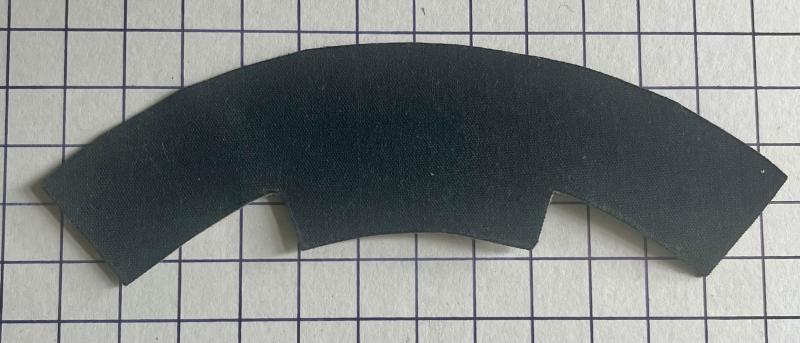c1943-45 First Hussars Canada Printed Shoulder Title Cloth Badge
Rare, in fantastic unissued condition First Hussars Canda shoulder title. Part of 2nd Bde they landed on D-day 6th June 1944.
In December 1943, the First Hussars were introduced to "Duplex Drive" (DD for short) tanks. Initially the regiment was trained on the Valentine DD, until it was re-equipped with the M4A4 Sherman DD and Sherman Vc "Firefly" in April 1944.
The DD tanks of the 1st Hussars were amongst the allied forces to come ashore in Normandy. The Hussars were to support the infantry landing on the western half of Juno Beach.
At 07:15, 19 tanks of 'B' Squadron launched their Sherman V DDs from their landing-craft into the English Channel some 4000 meters from shore of Nan Green Beach. Of 'B' Squadron's 19 tanks, 15 made it to shore ahead of the Regina Rifles, whom they were tasked to support.
'A' Squadron launched some of their DDs some ten minutes later than 'B' Squadron, from approximately 1500 meters out and headed towards Mike Beach. Only two of the four LTCs carrying 'A' Squadron were able to launch all their tanks off shore. Of 'A' Squadron's 19 tanks, 10 were launched into the channel with seven of those making it to shore. Five tanks were landed directly onto the beach, and four were stranded on a landing craft which struck a mine. The tanks of 'A' Squadron were to support the Winnipeg Rifles, who were already fighting on the beach when they came ashore.
At the beach, many of tanks of the 1st Hussars stayed partially submerged just off shore in a hull down position. After dropping their screens, they began engaging the German antitank guns, machine-gun nests and other strong points, allowing the infantry to break the beach defences and make its way inland. 'A' Squadron made its way inland to the village of Graye-sur-Mer where the Winnipeg Rifles were attempting to capture bridges over the Suelles River. 'B' Squadron helped clear Courseulles-sur-Mer before breaking out into the countryside.
At 08:20, 'C' Squadron's Sherman Vc Fireflies and Sherman IIIs were landed directly onto Mike Red beach, along with the regimental Headquarters Squadron. By this time, resistance at the beach had been cleared.
After clearing Courseulles-sur-Mer, The regiment made its way inland. South of Reviers, 'B' Squadron encountered a German 88 which knocked out six tanks before being put out of action. Seven Hussar crewmen were killed in the engagement. Due to these losses,'B' squadron was pulled back to the beach after the encounter. As mentioned above, 'A' Squadron moved on to Graye-sur-Mer where the Winnipeg Rifles were fighting to secure the village. 'A' Squadron joined the fight in support of the Winnipegs, along with elements of 'C' squadron who were catching up. After the village was captured, 'C' Squadron pressed on, with 2nd Troop reaching the regiment's objective of the Caen-Bayeux Highway, becoming the only Allied unit to reach its D-Day objective. One survivor of D-Day said that "A German soldier actually saluted us on our way to the objective. I guess he was surprised to see us this far inland". However, 2nd troop had to pull back, as they were too far ahead of the rest of the force and too few to hold the objective. At dusk, the regiment pulled back to the channel to rest. the 1st Hussars suffered 21 killed, 17 wounded during the actions of D-Day. 'A' Squadron was left with 9 tanks at the end of the day and 'B' Squadron was reduced to 4 tanks.
After D-Day, the 1st Hussars continued to support infantry as it advanced and faced German counter-attacks. On 9 June, the Hussars supported the Canadian Scottish as they re-took Putot-en-Bessin and engaged Panthers of the 1st Battalion, SS-Panzer Regiment 12 (of the 12th SS Panzer Division Hitlerjugend), destroying 6.
Battle of Le Mesnil-Patryedit
Main article: Battle of Le Mesnil-Patry
On the afternoon of Sunday, 11 June, 'B' Squadron of the 1st Hussars was decimated during an abortive attack with The Queen's Own Rifles of Canada on the hamlet of Le Mesnil Patry, North-West of Caen. Panzergrenadiers, pioneers and tanks of the 12th SS Panzer Division were able to ambush the tanks of 'B' Squadron in part due to intelligence gleaned from the Hussar's own radio traffic after capturing wireless codes from a destroyed Canadian tank on 9 June. Using Panzerfausts, Panzerschrecks and anti-tank guns, the German forces were able destroy 51 Shermans, and inflict 61 killed or missing, 2 wounded and 11 captured on the 1st Hussars. The Queen's Own Rifles suffered 55 killed, 33 wounded and 11 taken prisoner during the attack. The attack is remembered as "The Black Day", "Black Sunday" and the "Black Sabbath" within the Regiment. It accounted for roughly one third of the 1st Hussars' dead over the entire war.
Code: 318
250.00 GBP


